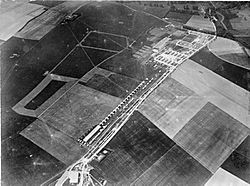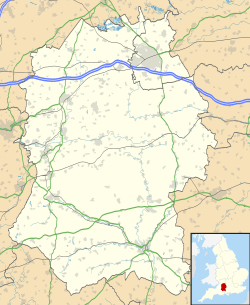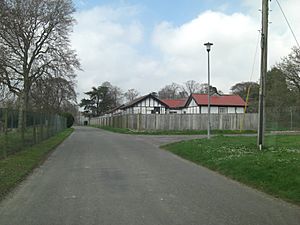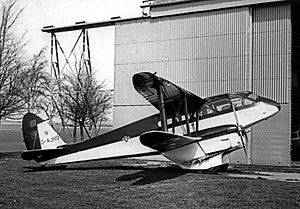Netheravon Airfield facts for kids
Quick facts for kids Netheravon Airfield |
|
|---|---|
| Netheravon, Wiltshire in England | |

"Concentration Camp" at RFC Netheravon, June 1914
|
|
|
Shown within Wiltshire
|
|
| Coordinates | 51°14′43.27″N 1°45′31.64″W / 51.2453528°N 1.7587889°W |
| Site information | |
| Owner | Ministry of Defence |
| Controlled by | Army Air Corps |
| Open to the public |
no |
| Site history | |
| Built | 1912 |
| In use | 1912 – present |
| Airfield information | |
| Identifiers | ICAO: EGDN |
Netheravon Airfield is a special grass airfield in Wiltshire, England. It's located on Salisbury Plain, a large area used by the military. This airfield has been important for flying for over 100 years! It started in 1913 with the Royal Flying Corps. Later, it became RAF Netheravon and then AAC Netheravon. Some of its original buildings from 1913 and 1914 are still standing today. Today, it's part of a bigger military area called Tidworth, Netheravon and Bulford Garrison.
Contents
Where is Netheravon Airfield?
This airfield is on Salisbury Plain, a huge open area. It's mostly in a place called Fittleton, but it also reaches into Figheldean. The airfield is very close to Netheravon village. It's about 5 miles (8 km) north of the town of Amesbury.
The buildings at Netheravon Airfield are split into two main spots. The buildings for flying, like the control tower and airplane hangars, are right next to the runways. About 1 mile (1.6 km) away, closer to Netheravon village, is Airfield Camp. This camp has offices, a training school, and places for officers and soldiers to live. The land around the airfield is also used by the Ministry of Defence for military training.
Early Days: Royal Flying Corps (1912–1918)
The military bought a lot of farmland around Netheravon in 1898. This was to create training areas. Netheravon Airfield, along with nearby Upavon and Larkhill, was key to the very first days of military flying. The Royal Flying Corps (RFC) was created in April 1912. This was the UK's first air force. Their main flying school was at Upavon.
The spot for Netheravon Airfield was chosen in late 1912. It was first called Choulston Camp. A road was built to connect Netheravon village to the airfield. At first, the soldiers lived in tents. But soon, new buildings were put up quickly. This was because they used ready-made parts. In June 1913, No. 3 Squadron moved here. No. 4 Squadron followed soon after.
In June 1914, before World War I started, many RFC planes and people gathered at Netheravon. This event was called the "Netheravon Concentration Camp." It was a big training exercise. It helped the RFC get ready for war and also showed the public how important they were. A magazine called Flight reported that "upwards of 700 officers and men" were there. They even published photos of many tents for the visiting squadrons.
When war was declared in August 1914, Squadrons 3 and 4 left for France. They went to support the British army. No. 1 Squadron then came to Netheravon to train new pilots. Netheravon became a place where new squadrons were formed. For example, No. 11 Squadron was formed here in February 1915. It then went to France in July. The airfield also had a training station. It trained aircrew, groundcrew, and other specialists.
Royal Air Force (1918–1963)
After the war, the RFC became the new Royal Air Force (RAF). Netheravon was used to break up squadrons that were no longer needed. In 1918, new hangars were built for large Handley Page O/400 bombers. But plans to make Netheravon a big bomber base were soon changed.
From 1919 to 1931, it was home to the No. 1 Flying Training School. Between 1924 and 1928, they even trained crews for the new Fleet Air Arm. Training started again in 1935 with No. 6 Flying Training School RAF. This school moved in 1938. Then, a new No. 1 Flying Training School took its place.
During World War II (1939-1945), many different squadrons stayed at Netheravon for short times. Training continued throughout the war. In 1941, Fleet Air Arm aircrew training moved to the United States. Squadrons like 297, 296, and 295 were based at Netheravon. In 1944, the airfield was used to get gliders ready. These gliders were used in the Normandy landings.
After World War II, the airfield was used for different things. This included training for the RAF Police. More homes for married soldiers were built at Airfield Camp in the 1950s. A Roman Catholic church also opened there around 1952.
Army Air Corps (1964–2012)
In 1963, the airfield was given to the Army Air Corps. It was then called AAC Netheravon. No. 651 Squadron moved here in 1964. They were in charge of Army aviation in the UK and the Middle East.
Later, the 7 Army Aviation Regiment was formed at Netheravon around 1969. In 1971, it was renamed 7 Regiment Army Aviation Corps. In 1995, 7 Regiment changed its role to become a volunteer Territorial Army regiment. This regiment moved to Middle Wallop in 2009.
For many years, the main office for the Brigade of Gurkhas was at Airfield Camp. This was until 2011, when it moved to Staff College, Camberley.
Netheravon Airfield Today
Today, Netheravon Airfield is used by the Joint Services Parachute Centre. This centre is part of the Army's "Adventurous Training" program. It helps soldiers, including those who have been injured, take part in exciting activities. The airfield is also home to the Army Parachute Association. This group helps serving and retired soldiers enjoy sports parachuting.
Historic Buildings at Netheravon
Some of the buildings at Netheravon Airfield are very old and important. They are called "listed buildings." This means they are protected because of their history.
The Officers' Mess and living quarters at Airfield Camp were finished in 1914. They are listed as Grade II*. This is a very high level of protection. The Mess building has two floors. The connected living block and nine small chalets have one floor. They were built using wood frames and special panels. These buildings are important because they are some of the oldest still standing from the early days of the RFC.
Six more buildings from the same time period are also listed as Grade II. A group of five connected hangars built in 1918 are also Grade II listed. Near the airfield, the main offices from 1914 are also Grade II listed. They are built in the same style as the camp buildings.
Images for kids











